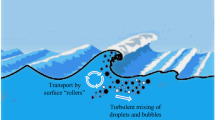Abstract
The paper proposes a new parameterization of natural dispersion of a marine oil spill due to wind-wave breakup of the oil slick and penetration of oil droplets into the water. The quantity of oil returning to the surface due to positive buoyancy in the time between wind wave overturns is estimated. The role of vertical turbulent exchange as a factor limiting oil droplet flux from the sea surface into the water column is discussed.
Similar content being viewed by others
Notes
The tilde denotes the intermediate result of flux estimation.
REFERENCES
R. S. Bortkovskii, Heat and Moisture Exchange between Atmosphere and Ocean during Storm (Gidrometeoizdat, Leningrad, 1983) [in Russian].
I. A. Brovchenko, “Model of the formation of a spectrum of oil drops in the surface layer of the ocean,” Prikl. Gidromekh. 6 (2), 20–26 (2004).
Z. N. Zatsepa, A. A. Ivchenko, K. A. Korotenko, et al., “The role of wind waves in oil spill natural dispersion in the sea,” Oceanology (Engl. Transl.) 58, 517–524 (2018).
A. Ivanov, B. Golubov, N. Evtushenko, and N. Terleeva, “Satellite mapping of oil spots and features of oil and gas capacity of the sites in the southern Caspian,” Zemlya Kosm.: Naibolee Eff. Resheniya, No. 4 (20), 20–26 (2015).
A. Yu. Ivanov, B. N. Golubov, and V. V. Zatyagalova, “Oil and gas capacity and unloading of underground fluids in the southern part of the Caspian Sea according to satellite radar data,” Issled. Zemli Kosm., No. 2, 62–81 (2007).
S. N. Ovsienko, S. N. Zatsepa, and A. A. Ivchenko, “Modeling of oil spills and risk evaluation of their environmental impact,” Tr. Gos. Okeanogr. Inst., No. 209, 248–271 (2005).
L. F. Titov, Wind Waves (Gidrometeoizdat, Leningrad, 1969) [in Russian].
T. Audunson, “The fate and weathering of surface oil from the Bravo blowout,” Mar. Environ. Res. 3 (1), 35–61 (1980).
A. V. Babanin, “Breaking of ocean surface waves,” Acta Phys. Slov. 59 (4), 305–535 (2009).
P. J. Brandvik, Ø. Johansen, U. Farooq, el al., “Sub-surface oil releases—Experimental study of droplet distributions and different dispersant injection techniques—version 2. A scaled experimental approach using the SINTEF Tower basin,” in SINTEF Report No. A26122 (Trondheim, 2014). ISBN 9788214057393.
G. A. L. Delvigne and L. J. M. Hulsen, “Simplified laboratory measurements of oil dispersion coefficient—application in computations of natural dispersion,” in Proceeding of the 17th Arctic and Marine Oil Spill Program (AMOP) Technical Seminar (Vancouver, 1994), Vol. 1, pp. 173–187.
G. A. L. Delvigne and C. E. Sweeney, “Natural dispersion of oil,” Oil Chem. Pollut. 4 (4), 281–310 (1988).
A. J. Elliott, “Shear diffusion and the spread of oil in the surface layers of the North Sea,” Dtsch. Hydrogr. Z. 39 (3), 113–137 (1986).
F. M. Fingas, “A review of natural dispersion models,” in Proceedings of the 37th AMOP Technical Seminar on Environmental Contamination and Response, June, 3–5, 2013 (Environment Canada, Ottawa, 2014), pp. 285–471.
W. D. Forrester, “Distribution of suspended oil particles following the grounding of the tanker Arrow,” J. Mar. Res. 29, 151–170 (1971).
An updated assessment of the risk for oil spills in the Baltic Sea area, Helsinki Commission (HELCOM), Finland, 2002. http://www.helcom.fi/stc/files/shipping/ RiskforOilSpillsReport2002.pdf.
O. Johansen, M. Reed, and N. R. Bodsberg, “Natural dispersion revisited,” Mar. Pollut. Bull. 93 (1–2), 20–26 (2015).
M. Li and C. Garrett, “The relationship between oil droplet size and upper ocean turbulence,” Mar. Pollut. Bull. 36, 961–970 (1998).
D. Mackay, I. Buist, R. Mascarenhas, and S. Paterson, Oil Spill Processes and Models, Report No. EE-8 (Environment Canada, Ottawa, 1980).
Y. Nakamura and N. Hayakawa, “Modeling of thermal stratification in lakes and coastal seas,” in Proceedings of an International Symposium “Hydrology of Natural and Manmade Lakes,” IAHS Publication Series no. 206 (International Association of Hydrological Sciences, Wallingford, 1991).
G. Neuman and W. J. Pierson, Principles of Physical Oceanography (Prentice-Hall, New Jersey, 1966).
O. M. Phillips, “Spectral and statistical properties of the equilibrium range in wind-generated gravity waves,” J. Fluid Mech. 156, 505–531 (1985).
R. Proctor, A. J. Elliott, and R. A. Flather, “Forecast and hind cast simulations of the Braer oil spill,” Mar. Pollut. Bull. 28, 219–229 (1994).
M. Reed, Ø. Johansen, F. Leirvik, and B. Brors, Numerical Algorithm to Compute The Effects of Breaking Waves on Surface Oil Spilled at Sea, Report F10968 (SINTEF Institute for Materials and Chemistry, Trondheim, 2009). https://crrc.unh.edu/sites/crrc.unh. edu/files/final_report_sintef_natural_dispersion_october-2009.pdf>.
M. Stramska and T. Petelski, “Observations of oceanic whitecaps in the north polar waters of the Atlantic,” J. Geophys. Res.: Oceans 108 (3), (2003). doi 10.1029/2002JC001321
P. Tkalich and E. S. Chan, “Vertical mixing of oil droplets by breaking waves,” Mar. Pollut. Bull. 44 (11), 1219–1229 (2002).
S. A. Thorpe, “The effect of Langmuir circulation on the distribution of submerged bubbles caused by breaking wind waves,” J. Fluid Mech. 142, 151–170 (1984).
S. Zatsepa, A. Ivchenko, and S. Ovsienko, “A local operative model for oil drift and dispersion,” in Proceedings of the Seminar “Combating Marine Oil Spills in Ice and Cold Conditions” (Helsinki, 1992), pp. 189–192.
ACKNOWLEDGMENTS
The study was financially supported by the Russian Foundation for Basic Research (project nos. 14-07-00513, 14-07-00434 and 15-07-04871).
Author information
Authors and Affiliations
Corresponding author
Additional information
Translated by A. Carpenter
Rights and permissions
About this article
Cite this article
Zatsepa, S.N., Ivchenko, A.A., Korotenko, K.A. et al. Phenomenological Model of Natural Dispersion of an Oil Spill in the Sea and Some Associated Parameterization Processes. Oceanology 58, 769–777 (2018). https://doi.org/10.1134/S0001437018060152
Received:
Accepted:
Published:
Issue Date:
DOI: https://doi.org/10.1134/S0001437018060152




